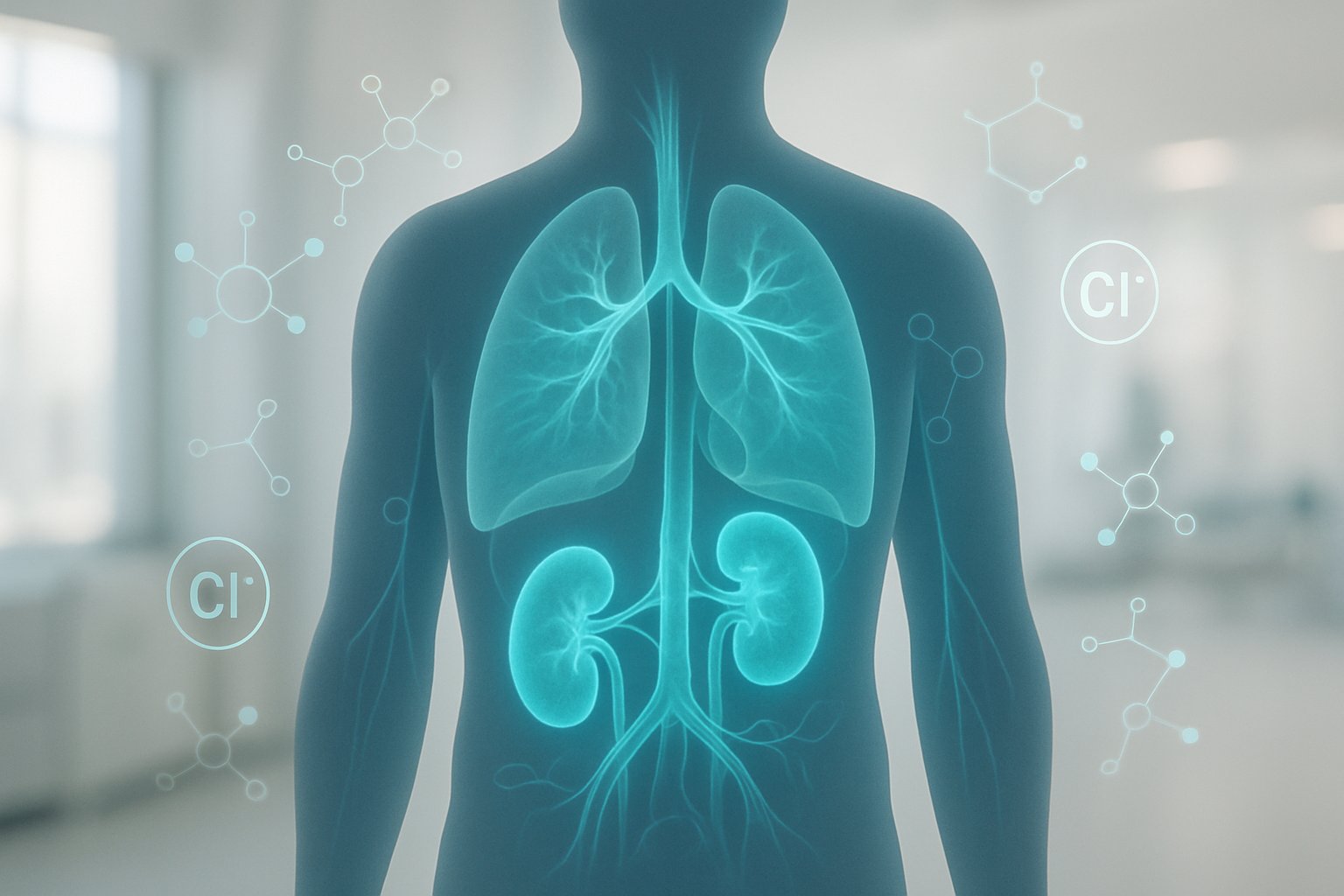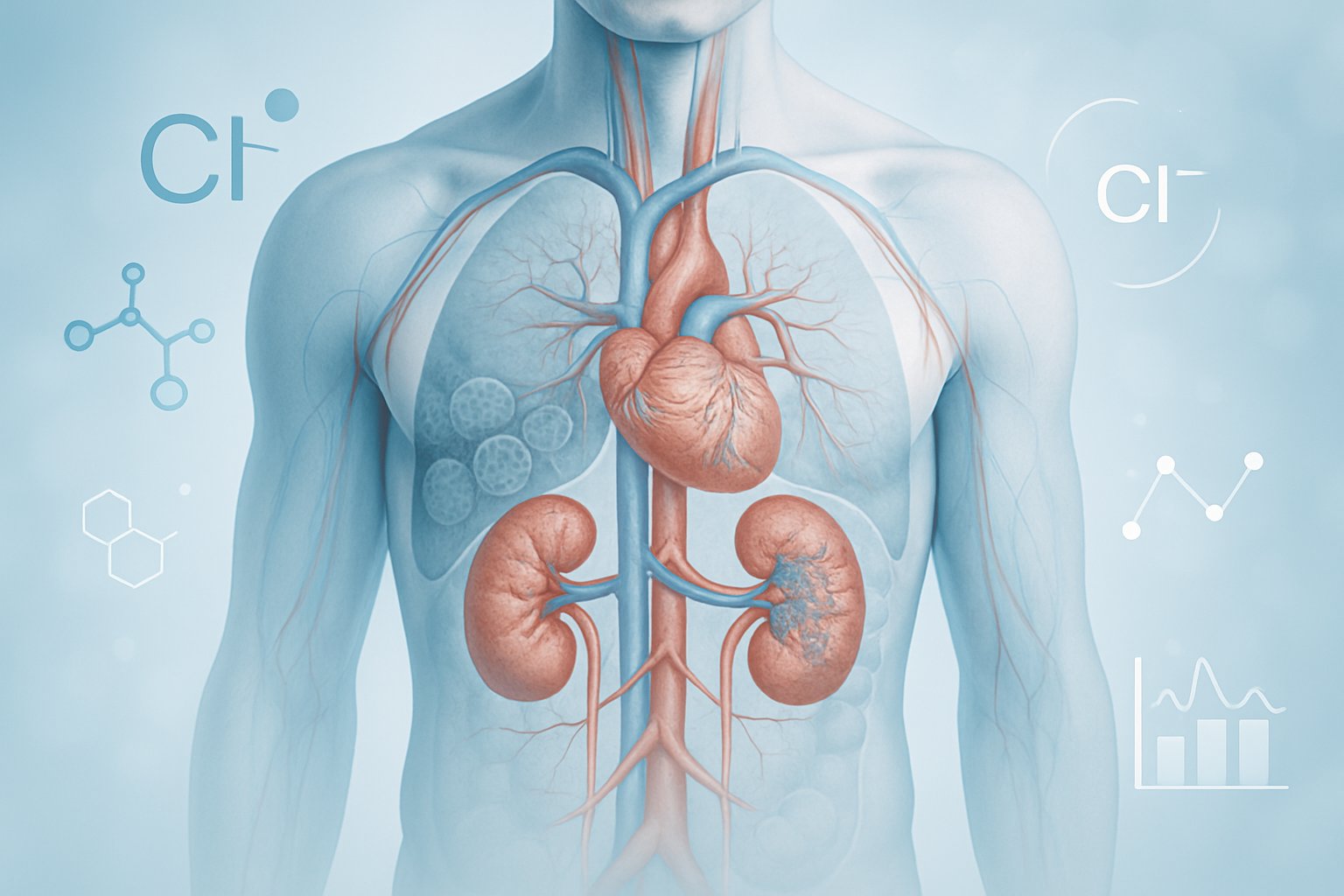Hyperchloremia and hypochloremia are the main diseases linked to chloride imbalances in the body. Chloride disorders can cause serious symptoms like muscle weakness, high blood pressure, and heart rhythm problems. Early diagnosis and treatment of chloride imbalances can prevent life-threatening complications.
Chloride imbalances in the body can lead to several serious health conditions, with the most common being hyperchloremia and hypochloremia. The primary diseases associated with chloride include hyperchloremia (high chloride levels), hypochloremia (low chloride levels), and hyperchloremic metabolic acidosis, which can cause symptoms ranging from muscle weakness to life-threatening complications.

Hyperchloremia occurs when chloride levels become too high[1] in the blood, often resulting from dehydration, kidney disease, or certain medications. This condition can lead to high blood pressure, fluid retention, and irregular heartbeats. On the opposite end, hypochloremia involves dangerously low chloride levels that can affect heart and lung function.
These chloride-related disorders highlight how critical this electrolyte is for normal body function. Chloride helps regulate blood pressure, maintains proper fluid balance, and plays a key role in digestion through stomach acid production. Understanding these conditions can help people recognize symptoms early and seek appropriate medical care.
Diseases and Disorders Related to Chloride Imbalance

Chloride imbalances can signal serious underlying health conditions and contribute to increased hospital mortality in critically ill patients. Both high and low serum chloride levels are linked to kidney disease, heart failure, and diabetes complications.
Hyperchloremia: Causes, Symptoms, and Health Risks
Hyperchloremia occurs when chloride levels in the blood become too high[1]. This condition often develops from dehydration, kidney disease, or diabetes insipidus.
Common causes include:
- Severe dehydration from diarrhea or excessive sweating
- Chronic kidney disease affecting chloride filtration
- Certain medications like carbonic anhydrase inhibitors
- Addison’s disease leading to salt cravings
Patients may experience high blood pressure, muscle weakness, and irregular heartbeats. In severe cases, hyperchloremia can cause breathing difficulties and confusion.
The condition may not cause symptoms by itself[1]. However, underlying causes can lead to serious complications like seizures and altered mental status.
Healthcare providers use blood tests to measure serum chloride levels. Normal chloride levels range from 96 to 106 milliequivalents per liter.
Hypochloremia and Its Clinical Consequences
Hypochloremia means having low chloride levels in the blood. This condition frequently occurs in hospitalized patients and is associated with increased mortality rates.
The main causes include excessive fluid loss through vomiting or diuretic use. Addison’s disease can also lead to low chloride levels[2] due to hormone imbalances affecting kidney function.
Patients with hypochloremia often develop:
- Metabolic alkalosis – blood becomes too alkaline
- Muscle cramps and weakness
- Breathing problems from pH imbalances
- Heart rhythm disorders
Studies using electronic health records show that low serum chloride levels predict worse outcomes in critically ill patients. The condition creates a cycle where diuretic resistance develops, making treatment more challenging.
Chloride and Kidney Disease
Kidney disease significantly affects chloride balance in the body. The kidneys normally filter and regulate chloride levels, but damaged kidneys cannot perform this function properly.
Chronic kidney disease causes chloride retention, leading to hyperchloremia. As kidney function declines, patients develop metabolic acidosis alongside elevated chloride levels.
Acute kidney injury (AKI) can cause rapid changes in serum chloride. Prospective cohort studies show that both high and low chloride levels increase mortality risk in AKI patients.
Renal disease creates a dangerous cycle. High chloride levels worsen kidney function, while poor kidney function leads to further chloride imbalances.
Healthcare providers monitor chloride levels closely in kidney disease patients. Treatment often involves dietary changes and medications to restore electrolyte balance.
Heart Failure, Diabetes, and Other At-Risk Conditions
Congestive heart failure patients frequently develop chloride imbalances. The condition reduces blood flow to kidneys, affecting chloride regulation and increasing hospital mortality rates.
Heart failure medications like diuretics can cause hypochloremia. This creates diuretic resistance, making fluid removal more difficult and worsening patient outcomes.
Diabetes affects chloride balance through multiple pathways. High blood sugar damages kidneys over time, leading to chronic kidney disease and chloride retention.
Diabetic patients also face increased infection risk, including sepsis. Sepsis causes rapid fluid shifts and electrolyte imbalances, including dangerous chloride levels.
Other high-risk conditions include:
- Severe burns causing fluid loss
- Prolonged vomiting or diarrhea
- Adrenal gland disorders
- Liver disease affecting protein production
Critically ill patients require frequent monitoring of serum chloride levels. Early detection and treatment of imbalances can reduce complications and improve survival rates.
Chloride’s Role in the Body and Factors Affecting Chloride Levels

Chloride serves as a vital electrolyte that maintains proper fluid balance and acid-base balance throughout the body. Multiple factors including other electrolytes, medications, dietary choices, and metabolic processes directly influence chloride concentration and can lead to serious complications.
Chloride Function in Acid-Base and Fluid Balance
Chloride works as a key electrolyte in maintaining the body’s acid-base balance. It helps regulate pH levels by interacting with bicarbonate ions in the blood and kidneys.
The body uses chloride to produce stomach acid for digestion. This process requires chloride ions to combine with hydrogen ions, forming hydrochloric acid in the stomach lining.
Chloride concentration directly affects fluid balance between cells and blood vessels. When chloride levels change, water moves to maintain proper balance across cell membranes.
The kidneys control chloride levels by either retaining or excreting it through urine. This process helps maintain stable blood volume and prevents dehydration.
Key functions include:
- pH regulation through bicarbonate exchange
- Stomach acid production for digestion
- Water distribution control
- Blood volume maintenance
Influence of Sodium, Potassium, and Other Electrolytes
Sodium and chloride work together as sodium chloride, commonly found in table salt. These two electrolytes move together through the body and affect each other’s levels.
When sodium levels rise, chloride typically increases as well. This relationship explains why high salt intake affects both electrolytes simultaneously.
Potassium influences chloride through kidney function. The kidneys balance these electrolytes to maintain proper cell function and nerve transmission.
Chloride interacts with other electrolytes[3] like bicarbonate to regulate various bodily functions. When one electrolyte becomes imbalanced, others often follow.
Electrolyte interactions:
- Sodium-chloride coupling in absorption
- Potassium-chloride exchange in kidneys
- Bicarbonate-chloride balance for pH control
- Calcium effects on chloride transport
Effects of Medications, Intravenous Fluids, and Diet
Diuretics commonly cause chloride loss through increased urine production. These medications force the kidneys to excrete more water, taking chloride with it.
Intravenous fluids can rapidly change chloride levels depending on their composition. Normal saline contains high chloride amounts that can cause elevation.
Processed foods typically contain high amounts of sodium chloride. Regular consumption of these foods increases both sodium and chloride intake significantly.
Ammonium chloride supplements or medications can directly increase chloride concentration in the blood. Medical professionals sometimes use these to treat specific conditions.
Major influences:
- Diuretics: Decrease chloride through urine loss
- IV saline: Increases chloride rapidly
- Processed foods: High sodium chloride content
- Medical supplements: Direct chloride addition
Metabolic Acidosis and Related Complications
Hyperchloremic metabolic acidosis occurs when chloride levels become too high relative to other electrolytes. This condition makes the blood more acidic than normal.
High chloride concentration can cause metabolic acidosis by disrupting the normal bicarbonate balance. The body struggles to maintain proper pH when chloride overwhelms other buffering systems.
Symptoms often include muscle weakness, fatigue, and breathing problems. Elevated blood pressure may also develop as the body tries to maintain fluid balance.
Severe cases can lead to organ dysfunction if left untreated. The kidneys, heart, and brain are particularly sensitive to acid-base imbalances caused by chloride disorders.
Complications include:
- Blood pH below normal range
- Muscle weakness and fatigue
- High blood pressure development
- Potential organ system failure
Frequently Asked Questions
Chloride imbalances can lead to serious health conditions, including cystic fibrosis and various electrolyte disorders. Blood tests help doctors identify these conditions and guide treatment decisions.
How is cystic fibrosis related to chloride levels in the body?
Cystic fibrosis affects how chloride moves through cell membranes. The disease causes defective chloride channels in cells.
This leads to thick, sticky mucus in the lungs and digestive system. The mucus blocks airways and traps bacteria.
People with cystic fibrosis have abnormal chloride transport in their sweat glands. This causes very salty sweat, which doctors use as a diagnostic test.
Can imbalances in chloride contribute to any specific medical conditions?
High chloride levels can cause muscle weakness and high blood pressure[1]. This condition is called hyperchloremia.
Hyperchloremic metabolic acidosis is a serious condition. It happens when the body cannot properly remove chloride from the blood.
Low chloride levels can cause muscle cramps and weakness. This condition often occurs with dehydration or vomiting.
What role does chloride play in maintaining respiratory health?
Chloride helps control the thickness of mucus in the airways. Normal chloride function keeps mucus thin and easy to clear.
When chloride channels do not work properly, mucus becomes thick and sticky. This makes it hard to breathe and increases infection risk.
The respiratory system depends on proper chloride balance for normal function. Chloride also helps maintain the right pH levels in lung tissues.
Are there known electrolyte disorders involving chloride?
Hyperchloremia occurs when blood chloride levels are too high. Dehydration and kidney disease[1] commonly cause this condition.
Hypochloremia happens when chloride levels drop too low. Excessive sweating, vomiting, or certain medications can cause this.
Bartter syndrome and Gitelman syndrome are genetic disorders. These conditions affect how the kidneys handle chloride and other electrolytes.
What diagnostic tests can identify diseases associated with chloride imbalances?
Blood testing helps doctors check electrolyte levels including chloride[1]. This is the main test for detecting chloride problems.
Sweat chloride tests diagnose cystic fibrosis. The test measures how much chloride is in a person’s sweat.
Urine tests can show how well the kidneys handle chloride. Doctors may also order tests to check kidney, liver, and adrenal gland function.
Which treatments are available for managing conditions associated with abnormal chloride levels?
Treatment depends on what is causing the chloride imbalance. Doctors may adjust medications or recommend dietary changes[1].
For high chloride levels, drinking more water and reducing salt intake[4] can help. Treating the underlying condition is also important.
Cystic fibrosis treatment includes airway clearance techniques and medications. These help thin mucus and fight infections.
Severe electrolyte imbalances may need hospital treatment. Doctors can give fluids through an IV to restore proper balance.
References
- Hyperchloremia: Causes, Symptoms, and Treatments. https://resources.healthgrades.com/right-care/symptoms-and-conditions/hyperchloremia Accessed October 25, 2025
- Low Chloride Levels: Causes, Symptoms, and Treatment. https://www.rupahealth.com/post/low-chloride-levels-causes-symptoms-and-treatment Accessed October 25, 2025
- The Biochemical Significance of Chloride. https://www.numberanalytics.com/blog/biochemical-significance-chloride-nutrition Accessed October 25, 2025
- Chloride Blood Test: What It Means If Chloride Is High. https://www.personalabs.com/blog/high-chloride-blood-test/ Accessed October 25, 2025
